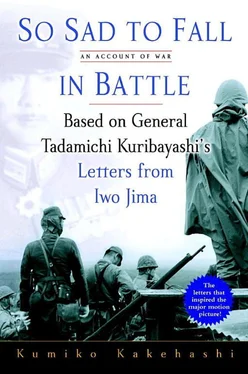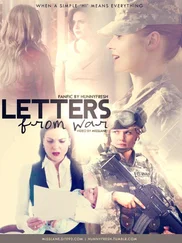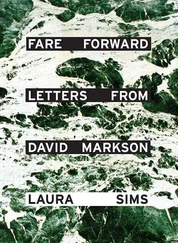He sometimes grumbled in his letters home, as in the letter to Yoshii on November 17, 1944: “I’m eating nothing but dried vegetables every day. They’re so dry and so hard that they’re driving me crazy. Seeing that I don’t seem to be getting any thinner, maybe they have nutritional value after all.” Plainly he had fulfilled his goal of learning about the nutritional state of his men through direct personal experience.
Kuribayashi encouraged each unit to cultivate their own vegetables in an effort to address the shortage. And once again, Kuribayashi was the kind of man who did not just issue an order, but led by example, as made clear in his letter of October 10, 1944:
I was thinking that we need to get fresh vegetables any way we can, so we’ve started to grow them by cultivating the waste ground. The results aren’t that great. No sooner do you think you’ve got a shoot coming, than in come the crickets and cockroaches and gobble it up.
Only a month after this griping letter (November 17, 1944), he reported happily: “Thanks to our hard work plowing up the ground and planting seeds all throughout the island, we now have a tiny crop which, amazingly, we’re able to eat.”
Kuribayashi’s habit of leading by example like this appears to have impressed his men. Major Komoto Kumeji, the adjutant general of the 109th Division, survived because he had to fly out to Tokyo for a meeting just before the American forces landed and was unable to return in time. After the war he gave the following account of Kuribayashi’s way of life on Iwo Jima in the book Tôkon Iô-Tô ( Fighting Spirit: Iwo Jima ), by Horie Yoshitaka:
As a leader, Division Commander Kuribayashi was strict about military discipline and believed in punctuality and prompt execution. At the same time, there was a side of his personality that overflowed with warmth. He was always making inspection tours of the island, and had a perfect memory for topography and natural objects. He personally directed the organization and construction of the defenses, and while so doing he would slip the cigarettes that were a gracious gift from the Emperor into the pockets of the hardworking troops, sharing them out. He used to brush his teeth and wash his face with a single cup of water.
Even the headquarters started growing vegetables, and they offered these around for cooking. They grew sweet potatoes, which is an all-year-round plant. We often used to pick just about a centimeter from the tips of the shoots, put them in hot water, add soy sauce, and eat them.
In July 1944, Lieutenant Colonel Asaeda Shigeharu, army chief of staff from the Imperial General Headquarters, visited Iwo Jima for strategy discussions. He had heard that fresh vegetables and water were in short supply, so he filled large baskets with freshly picked cucumbers, eggplants, and tomatoes and loaded these on the plane at Kisazaru Airfield along with some seventy-two-liter barrels of well water. He got to Iwo Jima and handed the supplies over to the soldiers on duty, who received them as if they were sacred objects. Things soon became lively with cries of “Hey, everyone! Bring your cups! Fresh water from the mainland’s here!”
It seems that Asaeda had prepared a separate consignment of vegetables for the commander in chief, and after the war he recounted his experience of delivering it directly to Kuribayashi.
I gave one basket of fresh vegetables to the division commander. With tears in his eyes, the general ordered his adjutant to use his knife to chop the vegetables up into small pieces and share them with as many men as possible below the rank of regimental commander. He did not take a single scrap for himself. On the contrary, he gathered up some papaya and made pickles, which he gave to the people around him. It was impressive; he was like a modern-day General Nogi. [1] From “Iô-Jima Kaisô no Ki” (“A Nostalgic Record of Iwo Jima”) in Ogasawara Heidan no Saigo ( The End of the Ogasawara Army Corps ) by Ogasawara Senyûkai Hen. Nogi Maresuke (1849–1912) was a Japanese general who took part in the Sino-Japanese War and the Russo-Japanese War, in which he bore the loss of his two officer sons with stoic acceptance. He and his wife committed suicide on the eve of the funeral of the Emperor Meiji, and Nogi became a symbol of loyalty and self-sacrifice.
IN MANY OF HER LETTERS, Kuribayashi’s wife expressed the wish to send him his whiskey ration and extra articles of food, or to give them to the liaison officers who shuttled between Tokyo and Iwo Jima to deliver. Kuribayashi, however, would always tell her “I’m in a more fortunate position than the soldiers, so have quite enough of everything,” or “The airplanes have more important freight to carry, so please don’t send me anything except letters.”
When Kuribayashi received some confectionery as a gift from the emperor, he sent it on to his family without touching it. It is rather moving how he adds a small note to his wife: “To be consumed only at home.” As a commander, Kuribayashi was stern and fair, but within his own family he was a completely ordinary father and husband.
MINING SULFUR AND MINERAL phosphates was the main industry on Iwo Jima. The climate and the soil quality were so poor that rice could not be cultivated, and the island’s only agricultural products were sugarcane and a handful of medicinal plants.
Nonetheless, when Kuribayashi arrived on the island, there were around a thousand full-time residents, the majority of whom lived in a village in the center of the Motoyama plateau. They were simple people who, though poor, were accustomed to living a tranquil existence.
During the air raids in June, Kuribayashi allowed the islanders, who had no dugouts of their own, to use the military air-raid shelters. Seeing the women and children running around in aimless bewilderment and diving into the air-raid shelter with whatever they had on at the time, Kuribayashi decided that the inhabitants should be sent to the mainland as soon as possible. He also thought that they would get in the way, and that having soldiers and civilians rubbing shoulders on such a tiny island was not a good idea.
The “Important Points from the Division Chief” that Kuribayashi published on June 17 include the clause: “In emergencies, there is nothing problematic about giving short-term shelter to the local people in the army dugouts. They cannot be accommodated after the air-raid siren has sounded the all clear or in the nighttime.”
The civilian population could be accommodated in military air-raid shelters to ensure their safety, but they had to be sent back to their homes immediately after the air-raid siren sounded the all clear, nor were any civilians allowed into the air-raid shelters at night. Kuribayashi also ordered that women should wear monpe pantaloons when air raids looked likely to occur. Perhaps he was trying to prevent any problems of public morals.
Kuribayashi was a puritan. No “comfort woman” station was erected on Iwo Jima, and one theory is that this was because of Kuribayashi’s disapproval.
The repatriation of the island’s residents started on July 3 and was completed by July 14. Men between the ages of sixteen and forty without dependents were conscripted, and the staff of the weather survey station was put to work for the navy, but otherwise everyone left the island. For a period of seven months prior to the American assault, Iwo Jima thus became an island only of men, with neither women nor children on it. It was uncomfortable and it was slightly cold-blooded, but it was best for the military to make their battle preparations with no civilians around. It was because Kuribayashi made this decision at an early stage that Iwo Jima was fought over without causing any civilian casualties.
Читать дальше












